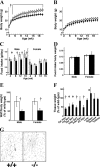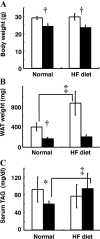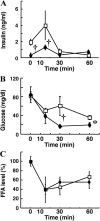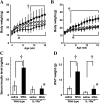IL-1 plays an important role in lipid metabolism by regulating insulin levels under physiological conditions
- PMID: 12975454
- PMCID: PMC2194201
- DOI: 10.1084/jem.20030299
IL-1 plays an important role in lipid metabolism by regulating insulin levels under physiological conditions
Abstract
IL-1 is a proinflammatory cytokine that plays important roles in inflammation. However, the role of this cytokine under physiological conditions is not known completely. In this paper, we analyzed the role of IL-1 in maintaining body weight because IL-1 receptor antagonist-deficient (IL-1Ra-/-) mice, in which excess IL-1 signaling may be induced, show a lean phenotype. Body fat accumulation was impaired in IL-1Ra-/- mice, but feeding behavior, expression of hypothalamic factors involved in feeding control, energy expenditure, and heat production were normal. When IL-1Ra-/- mice were treated with monosodium glutamate (MSG), which causes obesity in wild-type mice by ablating cells in the hypothalamic arcuate nucleus, they were resistant to obesity, indicating that excess IL-1 signaling antagonizes the effect of MSG-sensitive neuron deficiency. IL-1Ra-/- mice showed decreased weight gain when they were fed the same amount of food as wild-type mice, and lipid accumulation remained impaired even when they were fed a high-fat diet. Interestingly, serum insulin levels and lipase activity were low in IL-1Ra-/- mice, and the insulin levels were low in contrast to wild-type mice after MSG treatment. These observations suggest that IL-1 plays an important role in lipid metabolism by regulating insulin levels and lipase activity under physiological conditions.
Figures








References
-
- Dinarello, C.A. 1991. Interleukin-1 and interleukin-1 antagonism. Blood. 77:1627–1652. - PubMed
-
- Dinarello, C.A. 1996. Biologic basis for interleukin-1 in disease. Blood. 87:2095–2147. - PubMed
-
- Dinarello, C.A. 1998. Interleukin-1, interleukin-1 receptors and interleukin-1 receptor antagonist. Int. Rev. Immunol. 16:457–499. - PubMed
-
- Tocci, M.J., and J.A. Schmidt. 1997. Interleukin-1: Structure and function. Cytokines in health and disease, second edition. D.G. Remick and J.S. Friedland, editors. Marcel Dekker, Inc., New York.1–27.
-
- Horai, R., M. Asano, K. Sudo, H. Kanuka, M. Suzuki, M. Nishihara, M. Takahashi, and Y. Iwakura. 1998. Production of mice deficient in genes for interleukin (IL)-1α, IL-1β, IL-1α/β, and IL-1 receptor antagonist shows that IL-1β is crucial in turpentine-induced fever development and glucocorticoid secretion. J. Exp. Med. 187:1463–1475. - PMC - PubMed
Publication types
MeSH terms
Substances
LinkOut - more resources
Full Text Sources
Other Literature Sources
Medical
Molecular Biology Databases

